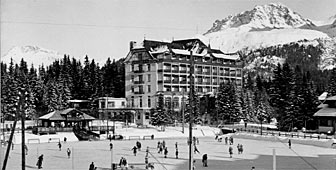Switzerland: A paradise sold?

A member of the crew on the paddle steamer, Unterwalden, hoists a flag at the boat's bow bearing the stars of Europe. Even though it's an overcast day, there's not an empty seat when the boat pulls away from the landing in Lucerne.
The Unterwalden sails past a number of magnificent hotels, some strung along the shore of Lake Lucerne and others looming over the water from their mountain perch.
The boat and buildings share a common heritage. They were all constructed during the Belle Époque about 100 years ago.
On this day, the passengers size up the beautifully restored boat and buildings with an unusually critical eye. They’re European and Swiss experts taking part in a three-day symposium titled, “Paradise Sold”, focusing on the uneasy partnership between tourism and heritage conservation.
The gathering was Switzerland’s contribution to “Europe, a common heritage” – a campaign launched by the Council of Europe.
“I’ve been struck by what voluntary private effort can do with the steamboats on Lake Lucerne [restored through private donations] where evidence of the past has been taken and turned into something profitable,” says British conservator, Christopher Young.
“I think the steamboat company demonstrates how tourism and the historic environment can work together. You have something from the past which people value and is still working for its living,” Young adds.
The aim of the symposium was to promote the view that the time is ripe for similar projects. Many conservators complain that the tourist industry doesn’t do enough to support preservation efforts, even though the famous landmarks figure prominently in tourism marketing campaigns.
Johann Mürner of Switzerland’s federal office for culture believes Switzerland can’t afford to allow the industry to exploit the country’s cultural resources for short-term gain. “Switzerland is a small, densely populated country and because of that, we have to be very careful about the decisions we take in future,” Mürner says.
It was Switzerland four years ago which initiated the Council of Europe programme “cultural heritages of tourism and travel” as part of the wider “Europe, a common heritage” campaign. The programme’s buzzword is sustainable development, with the goal of ensuring that cultural assets are passed on to future generations.
“We haven’t been very happy with the state of our relationship with the tourist industry. Our discussions haven’t been very fruitful. But I’m sure there’ll be progress,” Mürner says.
“We use monuments, we don’t abuse them,” counters Eva Brechtbühl from Switzerland Tourism. “We support them indirectly. The many foreign guests we attract pay to visit our museums, castles, historic buildings and other cultural sites.”
Cultural events are to the fore of Switzerland Tourism’s autumn promotions. And Brechtbühl says culture will also be the focus next spring. Its attractions will include a “customs and traditions trail” and an “arts and craft path” crisscrossing the country.
The passengers on the Unterwalden disembark at the village of Alpnachstad for a trip by cog railway up to the top of the 2,100-metre-high Mount Pilatus. The trip takes about 30 minutes, but used to take about an hour and a half when it operated on steam in the late 19th and early 20th centuries.
The top of the Pilatus is dominated by two hotels – in the opinion of some of the monument conservators – examples of the very best and worst built in the name of tourism.
The Bellevue Hotel is a round and characterless structure that went up in the 1960s. A short-stroll across a paved terrace is the Hotel Kulm.
The Kulm first opened its doors in 1890 and has been renovated with funding from local and national heritage offices. The renovations have brought a new gleam to high ornamental ceilings, pillars and woodwork in the various dining rooms.
But the head of Pilatus Railways, Rainer Flaig, believes the historical monuments in themselves are not enough to attract visitors. The Pilatus management has latched onto the mythical past to make the mountain more alluring.
The Pilatus logo is a red, fire-breathing dragon and a “Dragon Trail” at the top of the Pilatus illuminates the legend. “We have the dragon story. That’s part of our local culture. We promote the story and you can even see some ‘dragon stones’ in our museum,” Flaig says.
“People often say they feel the presence of dragons. Everybody knows a little bit about the legends, but fantasy is required to bring the story to life. Culture and fantasy go hand in hand.”
After much discussion, a fundamental difference remained over the question of how best to conserve the monuments left behind from the golden age of tourism. Many of the conservators spoke out in favour of a special tourist tax, while tourism representatives held firm that investments should be based on market forces alone.
There was general agreement, however, as one participant put it, that “stories are easier to sell than stones”.
by Dale Bechtel

In compliance with the JTI standards
More: SWI swissinfo.ch certified by the Journalism Trust Initiative

You can find an overview of ongoing debates with our journalists here . Please join us!
If you want to start a conversation about a topic raised in this article or want to report factual errors, email us at english@swissinfo.ch.